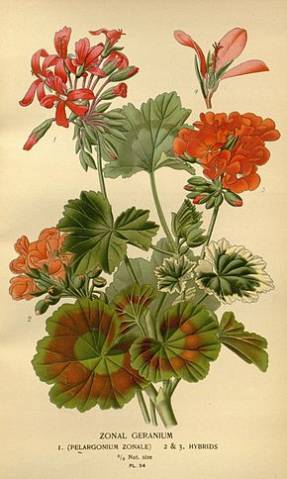
History claims that the first pelargonium came to Europe in 1600. She was sad pelargonium (Pelargoniumtriste), brought from the Cape of Good Hope to the Botanical Garden of Leiden (Holland). Thus, pelargonium has been grown for over 400 years.
Among them, zonal pelargonium is one of the "oldest". It was first discovered in 1689 in the Black Mountains gorge in the west of the Cape Province by a South African physician, botanist and artist of German origin G.B. Aldenland, who sent the plant to Europe, including the English Duchess of Beaufort (Mary Somerset), a keen gardener and botanist. The species was soon described by the Dutch botanist Jan Kommelin (1629-1692).
Pelargonium zonal (Pelargoniumzonale) - a South African plant, its range stretches from east to west of the Cape Province, in the north it captures the province of KwaZulu-Natal.
In the wild, this is a semi-shrub about 1 m high, often creeping along the ground. Semi-cut stems woody with age. Leaves are rounded in outline, from 2 to 8 cm in diameter, scalloped along the edge, usually having a dark stripe (zone) crossing the radial veins in a circle. The leaves are arranged on petioles about 5 cm long and have rather large webbed stipules. Flowers are collected in false umbrellas up to 50 flowers, towering above the foliage on the peduncle 2-3 times longer than the inflorescence. Petals are oblique lanceolate, pale pink, less often white or red, with dark veins. Each flower has 7 stamens and 2 very short pistils.
Flowering occurs throughout the year, peaking in the spring (September-October in the southern hemisphere).
Currently, zonal pelargoniums are unsurpassed in popularity and number of varieties. Thanks to hybridization, they have become much more beautiful than their wild ancestor. We are now talking about a whole group of zonal pelargoniums (Pelargoniumxhortorum). I wonder what the name Pelargoniumxhortorum, literally - garden pelargonium, appeared for varieties relatively recently - in 1916, thanks to the American botanist L. Bailey, who decided to separate garden pelargonium from indoor pelargonium, combining the latter under the name of home pelargonium (Pelargoniumxdomesticum).
Zonal pelargoniums are, indeed, suitable for garden cultivation (in our area - in the summer), for carpet beds, for containers and balcony boxes, for creating magnificent compositions with other flowers. However, in temperate climates it is more convenient to use specially bred F1 hybrids for this, which are easy to grow from seeds as annuals, see Pelargonium zonal.

The main parent form of the group Pelargoniumxhortorum is, of course, zonal pelargonium (Pelargoniumzonale), from which it got both its name and the dark zones on the leaves of plants. Another parent of the group is Pelargonium staining (Pelargonium inquinans) - without stripes, so modern varieties may not have this feature. Other species also took part in hybridization.
The advantage of zonal pelargoniums is long flowering - flowers in a hemispherical inflorescence open alternately from the center. They can be simple, semi-double or double, all kinds of colors (with the exception of blue and bright yellow), including two-colored, have a faint pleasant aroma. There are variegated and tricolor varieties, valued more for the decorative foliage than for flowering. Leaves often have a strong geranium odor and have phytoncidal properties.
According to the growth form, the "zonki" are divided into standard (at least 20 cm in height), dwarf (12-20 cm), miniature (below 12 cm), microminiature (10 cm), dicons (Deacon - hybrids similar in appearance to dwarf ), creeping or ampelous (Frutetorum or Cascade).
The emergence of many new products with other decorative features forces to constantly complicate the classification of zonal pelargoniums, the main groups can be found on the Pelargonium page.
One and the same variety can have a number of valuable decorative features and belong to several groups at once.Here we will focus on popular varieties and representatives of the most unusual groups of zonal pelargoniums. Examples of varieties with a wide variety of characteristics:
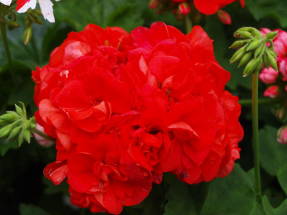 | 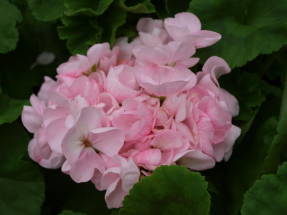 | 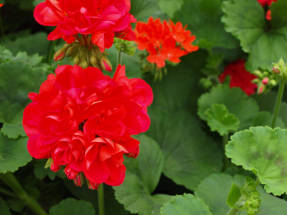 |
- Ashfield Monarch is a large pelargonium with huge orange-red inflorescences of semi-double flowers.
- Ashfield Serenade - a variety of the same series, but with pink semi-double flowers;
- Irene Toyon - up to 45 cm, with semi-double crimson-scarlet flowers in large inflorescences, leaves with a fuzzy zone;
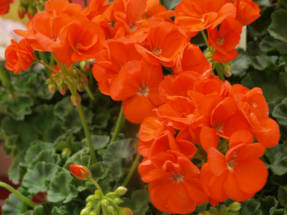 | 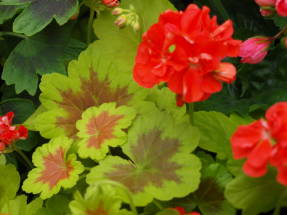 | 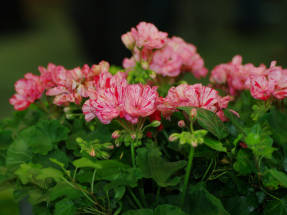 |
- Morning Sun - with large inflorescences of simple scarlet flowers, leaves with a brown zone.
- Occold Shield - profusely blooming double flowers in large inflorescences, with beautiful bronze foliage, which has a light green border;
- Peppermint Twist - a variety of the series Up to 35 cm tall, with rounded inflorescences of slightly fragrant red flowers, mottled with white strokes. The leaves are felted, with a noticeable zone.
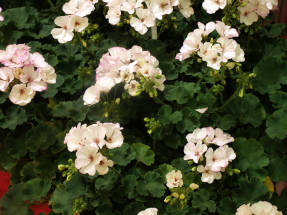 | 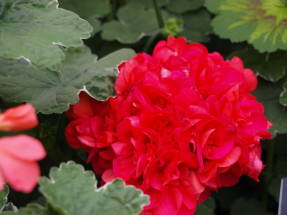 |  |
- Picotee Pink - compact, up to 30 cm, lush inflorescences, semi-double flowers with pale pink edging. Leaves with a fuzzy zone.
- Platinum - has lush salmon-colored spherical inflorescences, dark green foliage with white edging and a zone of bronze-colored to varying degrees;
- Madame Salleron is a dwarf zonal pelargonium up to 20 cm tall, with reniform white-variegated leaves on long petioles. It blooms rarely.
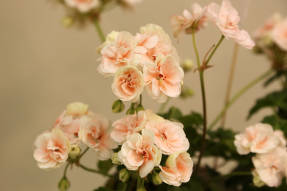 | 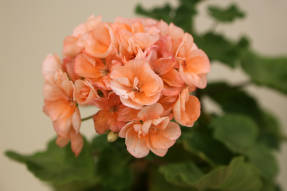 |  |
- PAC Salmon Comtess is a whole series of hybrid varieties, usually double, with 10-15 flowers in the inflorescence. Compact, profusely flowering, with dark green leaves.
- Something Special is a semi-double pelargonium with very large salmon pink flowers. Compact, with dark green foliage, which has a wide area.
- Sunstar Salmon - has simple bright salmon flowers with a white stripe in the center of the petal. Blooms are lush, leaves with a wide brownish zone, leaving only a green spot in the center of the leaf.
Deacons
Dwarf-like varieties with numerous double flowers. Their names always contain the word Deacon, often in an abbreviated form - D.
Bred by the English priest Stanley P. Stringer (1911-1986) by crossing the Orion Zonal Miniature Pelargonium with Blue Peter Ivy Pelargonium. This interspecific hybrid became the basis of the Deacon subgroup (Deacon - priest; deacon).
- Deacon Regalia is a fairly old variety (1978) with scarlet double flowers in globular inflorescences. Leaves with a barely noticeable zone.
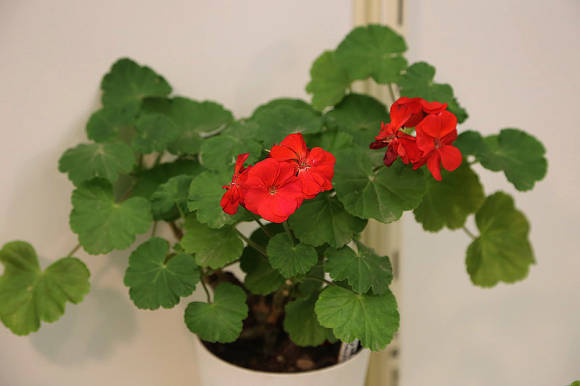
Tulip Flowered
A very small group of varieties, the flowers of which remain almost closed in the inflorescence, resembling a semi-double tulip. The pink-flowered Patricia Andrea, which was a sport from Fiat by an American grower named Andrea, was the first cultivar in this group. Tulip pelargoniums are often included in the group of terry zoned pelargoniums.
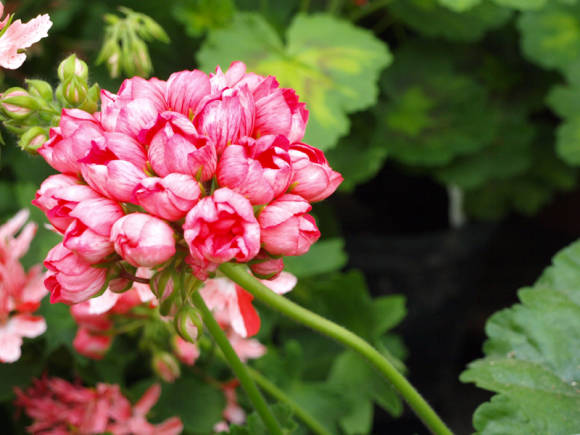
Rosaceae Pelargoniums (Rosebud or Noisette)
Rosebuds are hybrids with half-open double flowers that do not fully open. They have numerous petals, collected in the form of a rosebud.
- Denis is a compact variety reminiscent of the well-known Appleblossom Rosebud. Differs in a purer pink color of the buds, without a green tint. The flowers are double, pale pink, the petals are more saturated pink at the edges. The leaves are silvery green, with a blurred dark zone around the edge.
- Noel Gordon is a dwarf terry variety with dense large inflorescences of pink flowers. Leaves with a dark zone.
- Pink Rambler is a double-colored terry rosebud-pelargonium. The petals are coral red inside, white outside. The leaves have a dark area.
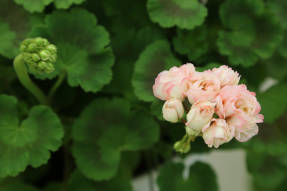 | 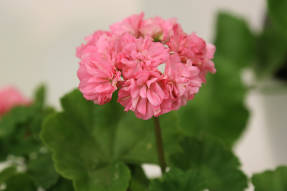 |  |
Stellar pelargoniums (Stellar)
Due to crossing with some species of Australian origin, these pelargoniums have star-shaped leaves and flowers. They are often referred to simply as stellars. Leaves with varying widths of the brown zone or spot, but may not have one. There are varieties with golden and tricolor leaves. The flowers are white, pink, red, sometimes two-colored - simple or double. The narrow, forked upper petals are longer than the lower ones with serrated edges. In outline, the flowers resemble a star. Variegated varieties and varieties with golden leaves are especially appreciated.
- Bob Newing is a miniature star-shaped pelargonium.The flowers are orange-red, but the main decoration of the variety is the tricolor leaves, which combine green with white edging and wine-red spots.
- Bronze Butterfly is a dwarf cultivar with salmon flowers and a brown leaf area in the shape of a butterfly.
- Chine - with bright red flowers and a brown zone on the leaves.
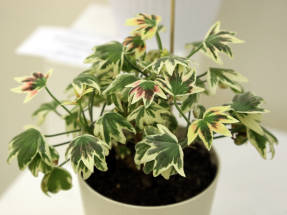 | 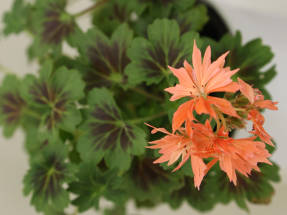 |  |
- Gosbrook Robyn Louse is a dwarf pelargonium with pink flowers and a brown zone that fills almost the entire leaf.
- Grandad Mac is a dwarf variety with large, dense buds. Flowers with forked salmon-red petals. Leaves are medium in size with a large brown spot.
- Kitbridge is a dwarf variety with golden star-shaped leaves and deep red double flowers.
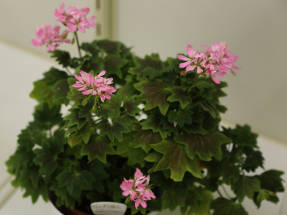 | 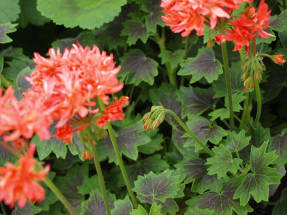 | 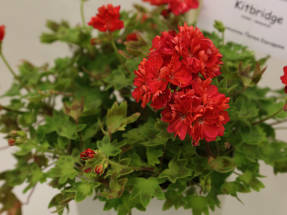 |
- Purple Heart is a dwarf variety with orange-red simple flowers. Beautiful leaves with a large dark purple spot.
- Rushmoor Red Star is a miniature cultivar with dark red double star-shaped flowers and yellowish leaves.
- Snowbrigth - with white double flowers with pink dots and dashes. The zone on the leaves is poorly expressed.
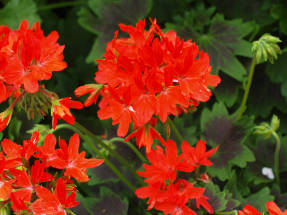 | 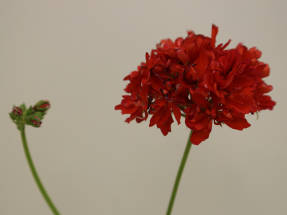 |  |
- Vectis Fineri is a standard pelargonium with lush pompoms of lavender-pink inflorescences. The foliage is beautiful, with an unexpressed dark zone.
- Vectis Glitter is a compact variety with large, double flowers, pale pink. The petals are serrated, the upper ones are narrow and long, the three lower ones are diamond-shaped. The leaves are small, serrated, green.
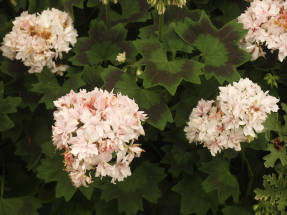 | 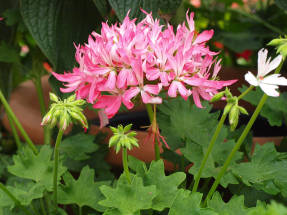 |
Bird eggs (Bird’sEggs)
This group of varieties got its name from the original color of the petals. At the base of each petal, it has an egg-shaped spot, often with specks resembling quail eggs. The spots are clearly visible on the petals of white, pink, lavender, coral.
- Starflecks - flowers are stellate, five-petalled, pink, with irregular red spots and stripes, leaves with a wide dark zone.
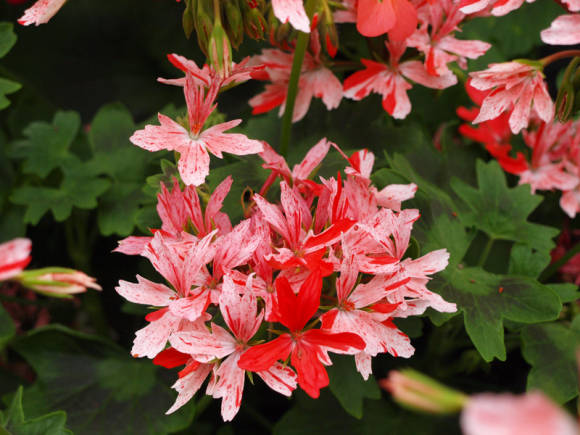
About cultivation - in the article Pelargonium: growing, care, reproduction









